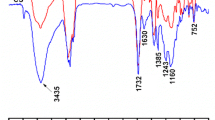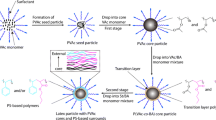Abstract
Core–shell latex particles made of a poly(butyl methacrylate) (PBMA) core and a thin polypyrrole (PPy) shell were synthesized by two-stage polymerization. In the first stage, PBMA latex particles were synthesized in a semicontinuous process by free-radical polymerization. PBMA latex particles were labeled either with an energy donor or with an energy acceptor, in two different syntheses. These particles were used in a second stage as seeds for the synthesis of the core–shell particles. The PPy shell was polymerized around the PBMA core latex in an oxidative chemical in situ polymerization. Proofs for the success of the core–shell synthesis were obtained using nonradiative energy transfer (NRET) and atomic force microscopy (AFM). NRET gives access to the rate of polymer chain migration between adjacent particles in a film annealed at a temperature above the glass-transition temperature T g of the particles. Slower chain migration of the PBMA polymer chains was obtained with the PBMA–PPy core–shell particles compared to rate of the PBMA polymer chain migration found with the pure, uncoated PBMA particles. This result is due to the coating of PBMA by PPy, which hinders the migration of the PBMA polymer chains between adjacent particles in the film. This observation has been confirmed by AFM measurements showing that the flattening of the latex film surface is much slower for the core–shell particles than for the pure PBMA particles. This result can again be explained by the presence of a rigid PPy shell around the PBMA core. Thus, these two complementary methods have given evidence that real core–shell particles were synthesized and that the shell seriously hinders film formation of the particles in spite of the fact that it is very thin (thickness close to 1 nm) compared to the size (750 and 780 nm in diameter) of the PBMA core. Transparency measurements confirm the results obtained by NRET and AFM. When the films are placed at a temperature higher than the T g of PBMA, the increase in transparency is faster for films made with the uncoated PBMA particles than for films made with the coated PBMA particles. This result indicates again that the presence of the rigid PPy layer around the PBMA core reduces considerably the speed at which the structure of the film is modified when heated above the T g of PBMA.
Similar content being viewed by others
Author information
Authors and Affiliations
Additional information
Received: 02 September 1999 Accepted: 21 December 1999
Rights and permissions
About this article
Cite this article
Huijs, F., Lang, J. Morphology and film formation of poly(butyl methacrylate)–polypyrrole core–shell latex particles. Colloid Polym Sci 278, 746–756 (2000). https://doi.org/10.1007/s003960000304
Issue Date:
DOI: https://doi.org/10.1007/s003960000304




